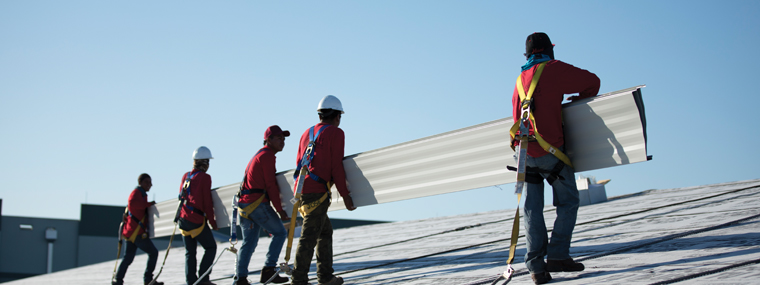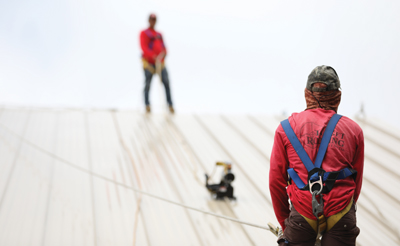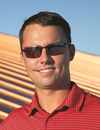
Minimize Risks in Roofing
By Casey Crowther / Published June 2020

Certain types of occupations seem inherently dangerous, like being a stuntman, iron worker, race car driver, or firefighter. According to the U.S. Bureau of Labor Statistics, though, the most dangerous occupations in America are in the industries of logging, fishing, and aircraft operations. Coming in as the fourth most dangerous occupation, with 51.5 fatal injuries per 100,000 workers, is roofing. Many more roofers suffer non-fatal injuries like cuts, bruises, muscle tears, ligament damage, and broken bones.
Safety is such a significant concern within the roofing industry that the Occupational Safety and Health Administration (OSHA) created a 44-page guidance document titled Protecting Roofing Workers, which outlines dozens of safety measures that roofing contractors can—and should—take to keep their employees and customers safe. What makes roofing so dangerous? Sloped roofs are inherently difficult to walk on, and your footing is never solid on shingles or tiles. One wrong move, and you’re tumbling 15 feet or more to the ground. If a roof has a leak, it’s likely that water penetrated the roof decking and could have caused rotting. Again, one wrong step, and a roofer could be falling inside the building.
Then there are roofing chemicals, potentially toxic fumes, blistering heat, dangerous UV rays, power tools, extremely heavy materials, and, of course, the heights.
[adrotate group=”1″]
Ultimately, the safety of roofers or any other worker falls on the employer. Target Roofing & Sheet Metal takes this responsibility seriously and has introduced a number of safety measures to protect team members from the hazards of the job, including the following items:
- Training—New employees undergoing a rigorous, multi-part training program that includes viewing a series of safety videos created by in-house safety specialists, as well as a review of best practices for the industry and on-the-job training.
- Safety equipment—Every roofer must wear a personal fall arrest system, a network of harnesses designed to keep roofers from falling. It must be worn at all times. Ladders, scaffolding, and aerial lifts are regularly inspected and must be placed on secure, stable footing. Employees also must wear safety goggles and hardhats when appropriate (as determined by the employer).
- Organization—Loose roofing materials, equipment, and supplies can pose trip or slip hazards, so any objects on a roof—TPO rolls, tiles, shingles or ropes—must be organized.
- Attire—Roofers must wear hard-soled, non-slip footwear for solid traction, as well as long pants and a long-sleeved shirt. All roofers must wear some type of headwear: either a hardhat, baseball cap, or wide-brimmed hat that protects against sun exposure. Gloves are a must when working with roofing materials, machinery, and torches.
- Weather—Project leaders use their eyes, ears, and apps to monitor the weather. Florida had more than 13 million cloud-to-ground lightning strikes in 2019, so the general guideline is that if a team member sees lightning or hears thunder, crews must seek shelter. Crews also use their judgment whether to access sloped roofs that are still wet from rain or dew.
Safety extends beyond just employees to also include customers and clients. As a commercial roofer, Target Roofing’s portfolio includes high-rises, apartment buildings, condominiums, shopping plazas, churches, schools, and government facilities. Many of these buildings are occupied while crews are working, so there is a responsibility for the safety of those employees, patrons, and residents. That means making sure equipment and materials are secure and do not present any trip, slip, or fall hazards. Whenever possible, the company should use its own crane to lift materials and supplies onto a roof rather than using interior stairwells or elevators used by building employees or occupants. When tearing off materials in reroofing jobs, crews do not throw objects toward the ground.
Licensed, reputable contractors will have general liability insurance and workers’ compensation insurance to cover their employees in the event of a workplace injury. However, property owners still can be liable if they weren’t forthcoming about disclosing potential hazards, such as if that owner knew about a warped roof deck, protruding nails, or electrical malfunctions but failed to notify the contractor.
Liability alone should give property managers and owners enough incentive to work only with licensed, certified contractors that value safety as a priority.
Casey Crowther
President, Target Roofing & Sheet Metal
Casey Crowther is a fifth-generation roofer and president of Target Roofing & Sheet Metal, a licensed and insured commercial roofing specialist headquartered in Fort Myers.
For more information, please visit TargetRoofers.com or call (239) 334-7496.





